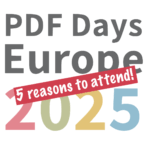Busting the Myth that PDF Cannot Be Accessible

Taking a break from his duties as Bizware’s CEO to focus on Access2online, what he considers his legacy project, Peter Shikli is the CEO. With his hundreds of hands-on website developments since 1995, Mr. Shikli is also a product of the WebAIM school of web accessibility. He has also personally … Read more


"The overwhelming majority of PDFs from faculty, publishing houses, etc. are not accessible at all," says Bevi Chagnon of PubCom. Indeed a sad starting point as far as our disabled PDF readers are concerned, but the more important question is whether that must also be our ending point.
This negative assumption is supported by the fact that when compared to HTML, the tags and techniques to make PDFs accessible are rather sparse. Not only does HTML have more native tags and attributes, but the W3C has fielded the additional ARIA tags on top of HTML specifically to address accessibility.
The question that remains however is whether web pages are born accessible because they are HTML and so very ready to be accessible. The factual answer is that web pages, PDFs, and all online content become accessible because their authors make them accessible. The carpenter's impressive tool collection does not build a house; the carpenter does.
The huge variety of website design tools and techniques present both opportunities and threats to accessibility. A dynamic website crammed with java-powered dancing balloons may be a feast for the eyes, but quite a challenge if your eyes don't work.
"I can make most any PDF accessible easier than I can a website designed to entertain more than to inform," says Alicia Breckheimer of Access2online. Therein is the rub. As web designers try to outdo one another with entertaining extravaganzas, the disabled, and a great many who are not, are left trying to thread their way through the eye candy to the answers they seek, to the content that inspires. An InDesign production can get rather flamboyant, for example, but it doesn't have all the HTML, Javascript, PHP, etc to turn into a truly hot mess from an accessibility standpoint.
Not as often, we also hear the rationale that browsers make web pages accessible to screen readers much more easily and effectively than they do PDFs. We don't actually disagree, but that's because browsers were not designed to display and read PDFs. PDF readers such as Adobe's Acrobat preceded the web and do a fine job presenting PDFs to screen readers. Browsers couldn't read PDFs at all until plugins came along that could, and now are built in, but with only some functionality.
And in closing, we come to a need that disabled people have, particularly when it comes to educational content such as textbooks. They need them to be portable and printable. By portable, we mean they need to make a local copy, and I don't mean to do a save-as on a web page yielding a folder full of components that may or may not work together when saved locally. By printable, I mean pagination faithful to the original design and synchronized to a table of contents, another challenge for HTML. When it comes to portability and printing, the "P" in PDF is your clue as to which can do that well.




